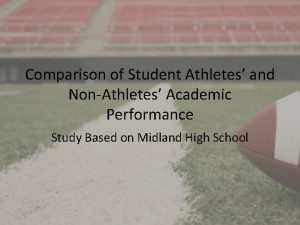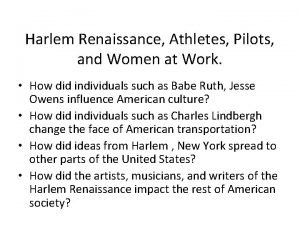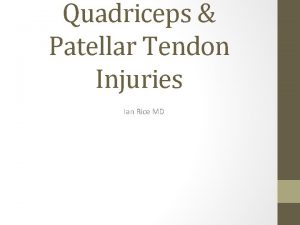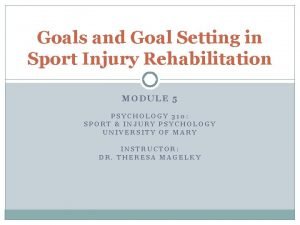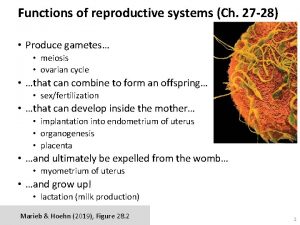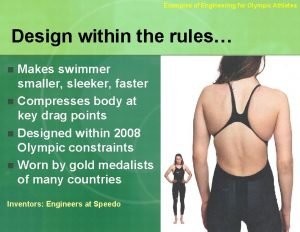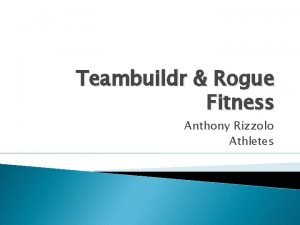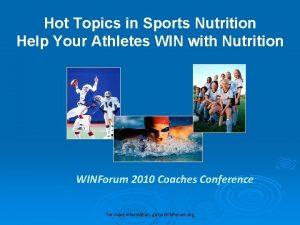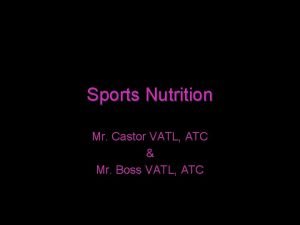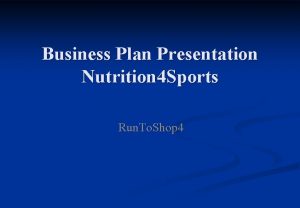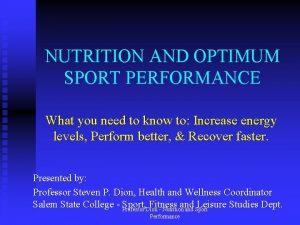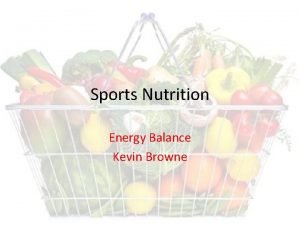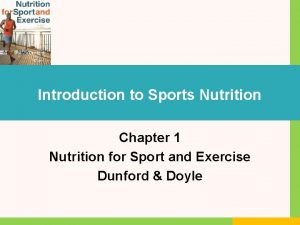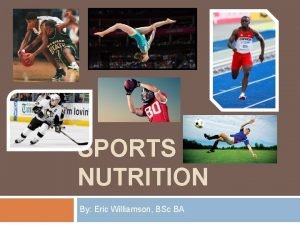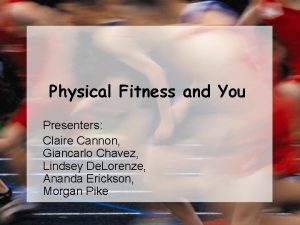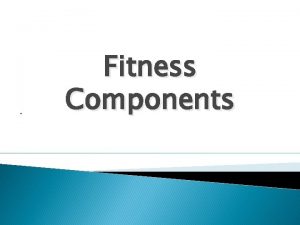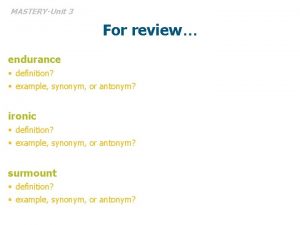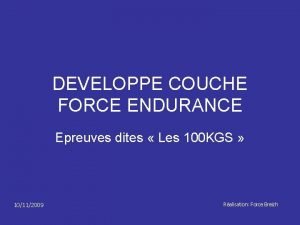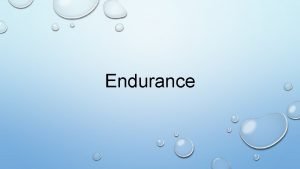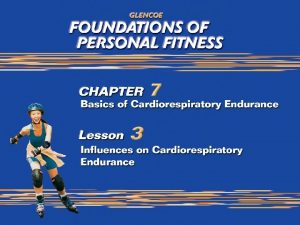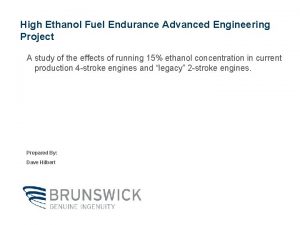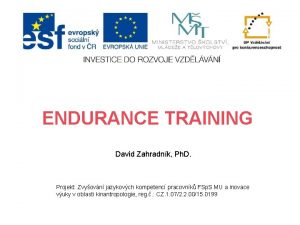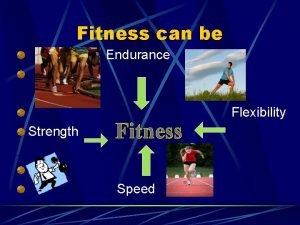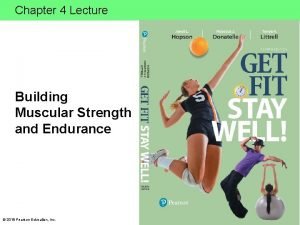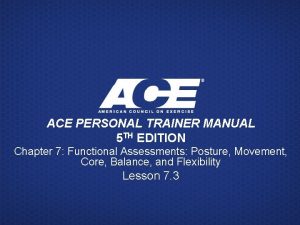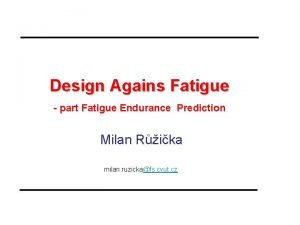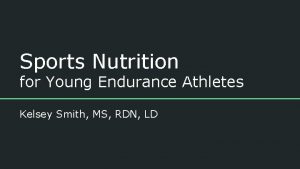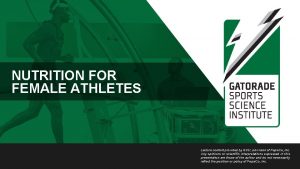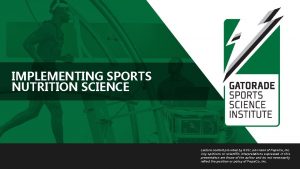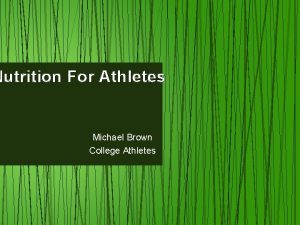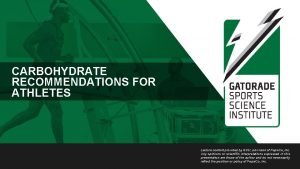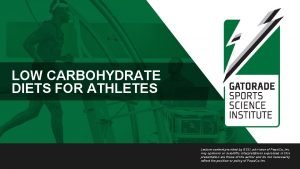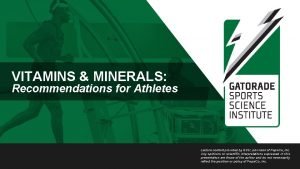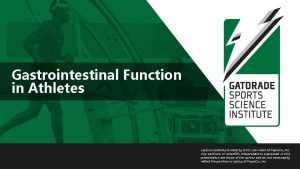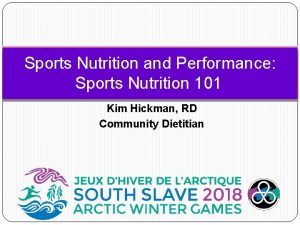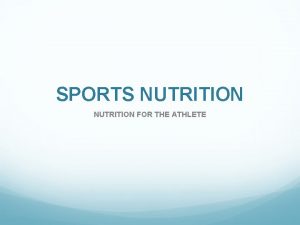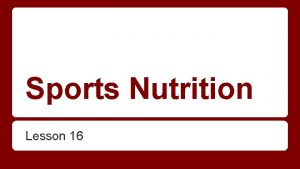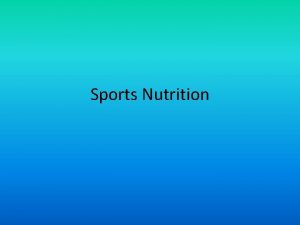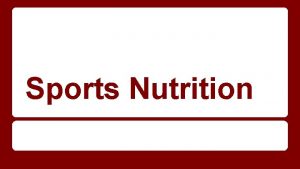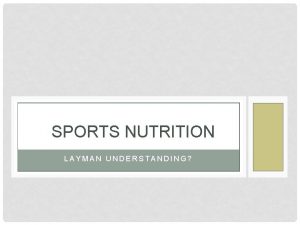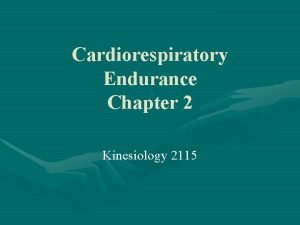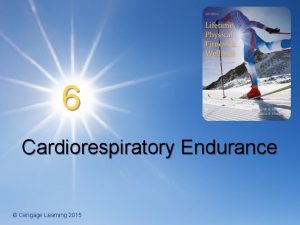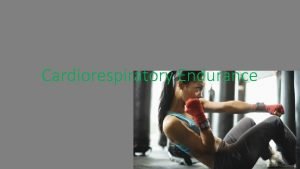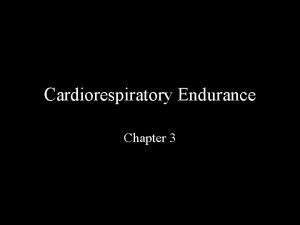SPORTS NUTRITION FOR ENDURANCE ATHLETES Lecture content provided











































- Slides: 43

SPORTS NUTRITION FOR ENDURANCE ATHLETES Lecture content provided by GSSI, a division of Pepsi. Co, Inc. Any opinions or scientific interpretations expressed in this presentation are those of the author and do not necessarily reflect the position or policy of Pepsi. Co, Inc.

Lecture Outline The endurance athlete Energy Hydration Structure Key takeaways

THE ENDURANCE ATHLETE

What do you think are some unique characteristics of an endurance athlete (think marathon runner or Ironman triathlete) that might impact their nutrition needs?

Endurance athlete considerations All Athletes § Use and need fuel for energy to train/compete § Sweat and need hydration § Use muscles and need strength Endurance Athlete Specific § Train and compete for long durations – typically 2+ hours at a time § Low-moderate intensity exercise § Steady state vs. intermittent high intensity exercise § Sport specific: runners, cyclists, or triathletes § Compete in marathons, triathlon, and ultra endurance events

ENERGY HYDRATION STRUCTU RE

Carbohydrate improves endurance performance Consuming carbohydrate during exercise results in: • Maintenance of blood glucose levels • Maintenance of carbohydrate oxidation • Spares muscle and/or liver glucose supplies Coyle EF, Coggan AR, Hemmert MK, et. al. J Appl Physiol. 1986; 61(1): 165 -172

One of the first studies to show that Carbohydrate ingestion benefits endurance exercise Blood glucose (mmol/L) CHO oxidation (g/min) 5. 0 4. 5 4. 0 3. 5 3. 0 2. 5 2. 0 0 60 120 Time (min) 180 240 Muscle glycogen (mmol/kg ww) 2. 6 200 2. 2 150 1. 8 100 1. 4 50 1. 0 0 0 60 120 Time (min) 180 240 0 60 120 180 240 Time (min) Coyle EF, Coggan AR, Hemmert MK, et. al. J Appl Physiol. 1986; 61(1): 165 -172

Carbohydrate is limited in the body Energy is stored in the body as fat and carbohydrate § Fatty acids are stored in the adipose tissue § Everyone, even the leanest athletes have enough stored fats to exercise for a very long time § The body relies primarily on fats during lower intensity exercise § Carbohydrates are stored in the liver and the muscles § There is limited storage capacity for carbohydrate § The body relies primarily on carbohydrates during higher intensity exercise § Eating carbohydrates helps replenish glycogen stores van Loon, L. J Appl Physiol (2004) 97(4): 1170 -1187, https: //doi. org/10. 1152/japplphysiol. 00368. 2004

As intensity increases, carbohydrate use for energy increases and fat decreases 1. 0 5. 0 0. 9 4. 5 0. 8 0. 7 4. 0 CARBOHYDRAT 3. 5 E 0. 6 FAT (g/min) FAT 3. 0 0. 5 2. 5 0. 4 2. 0 0. 3 1. 5 0. 2 1. 0 0. 1 0. 5 0. 0 CARB (g/min) INTENSITY Jeukendrup & Achten. Eur J Sports Sci. 2001; 1(5): 1 -5

Exercise intensity & carbohydrate utilization Exercise intensity impacts how quickly our muscle glycogen stores are used up § At lower levels of exercise intensity muscle glycogen utilization is spared § The blue line indicating 31% exercise intensity shows that exercise time is extended and muscle glycogen decreases slower § At high levels of exercise intensity muscle glycogen is utilization accelerates § The purple line indicating 150% exercise intensity shows that exercise time is limited and muscle glycogen decreases sharply § In general, there is a dose/response relationship between exercise intensity and muscle glycogen use

Substrate utilization & exercise duration Endurance Athlete Zone 100 MUSCLE TRIGLYCERIDES 80 PLASMA FFA 60 % of Energy Expenditure 40 BLOOD GLUCOSE* 20 MUSCLE GLYCOGEN 0 0 1 2 3 4 Exercise Time (hrs) Coyle EF. Am J Clin Nutr. 2000; 72(2): 512 S-520 S

Enhancing carbohydrate stores - chronic • We can adapt how much carbohydrate is stored in our muscles through diet Time to Exhaustion (min) • In this study, those with higher carbohydrate diet (red oval) have significantly more muscle glycogen • Those with higher carbohydrate diets have longer time to exhaustion Muscle Glycogen (mmol. kg dw-1) Bergstrom J, Hermansen L, Hultman E, et. al. Acta Physiol Scand. 1967; 7(2 -3): 140 -150

Enhancing carbohydrate stores - acute There are few ways that we can absorb carbohydrate through our gut • Glucose is absorbed via the SGLT 1 transporter • This transporter can only sustain a rate of 1. 0 g/min or 60 g/h • Carbohydrate sources, like glucose are absorbed quickly That doesn’t mean there isn’t a role for a slow sugar, like fructose • It has a separate transporter, the glut 5 transporter • It can be absorbed in addition to the 60 g/h of glucose • Slowly absorbed carbohydrate, you would not want to consume much more than 30 g/h. This combined type of carbohydrate is especially important for endurance athletes This is why carb recommendations aren’t based on body weight, but are standard amounts based on exercise duration SSE#10 8 Jeukendrup AE. Sports Science Exchange. 2013; 26(108): 1 -5

CARBOHYDRATE TRANSPORTERS SGLT 1 GLUCOSE ~60 g/h max INTESTINAL LUMEN GLUT 5 FRUCTOSE ~30 g/h max FRUCTOSE BLOODSTREAM

Single source carbohydrate Multiple source carbohydrate Carbohydrate intake and use • The body’s ability to use the carbohydrate we take in is limited • We are able to use about 1 gram of glucose alone per minute • We can use, more multiple source carbohydrate of glucose and fructose • We can increase it to about 1. 5 grams per minute of carbohydrate • However, if we try to take in more than about 1. 5 grams per minute combined type, we do not seem to get any additional benefit – and typically end up with GI discomfort. Jeukendrup AE. Curr Op Clin Nutr Metab Care. 2010; 13(4): 452 -457

• Multiple sources of carbohydrate of glucose and fructose emptying the gut quicker • This resulted in the fluid and carbohydrate getting into the blood faster than glucose and almost as fast as water • This means that the body can use this fluid and fuel quicker Plasma 2 H 2 O enrichment (ppm) compared to t=60 sample Multiple source carbohydrate improves fluid delivery Water Glucose + Fructose Glucose Time (min) Jentjens RLPG, Underwood K, Achten J, et. al. J Appl Physiol. 2006; 100(3): 807 -816

Performance and Carbohydrate Blends Time Trial Performance (Duration) Performance and carbohydrate blends 19% 01: 15 8% 01: 07: 00 01: 00: 41 01: 00 00: 56: 07 00: 45 00: 30 Glu+Fru Glu Placebo Currell K & Jeukendrup AE. Med Sci Sports Exerc. 2008; 40(2): 275 -281

Carbohydrate during training and competition Duration CHO (g/hour) Type <30 min None - 45 -75 min Very small amounts Most carb forms or mouth rinse 1 -2 hours Up to 30 g/h Most carb forms 2 -3 hours Up to 60 g/h Rapidly oxidized sugars Examples: sucrose, glucose, maltodextrin > 2. 5 -3 hours Up to 90 g/h Blend glucose + fructose Thomas TD, Erdman KA, Burke LM. Med Sci Sports Exerc. 2016; 48(3): 543 -568

Amount of Carbohydrate (grams) Examples of how to use the recommended carbohydrate amounts 90 4 hour Ride 60 2 hour Run 30 1 hour Swim 0

GI issues with carb intake • The stomach is an organ that can be trained Train your gut • It is important that an athlete gradually increase the amount of fluid and fuel intake during exercise to meet the recommendations • Consuming more fluid or carbohydrates than an athlete is used to can result in a “sloshy” stomach and other more intense gastrointestinal (GI) discomfort Stellingwerff & Jeukendrup. JAP. 2011 Murray R. Curr Sports Med Rep. 2006; 5(3): 161 -164

Summary: Energy • Carbohydrate is well known to improve endurance • Endogenous stores are limited and disappear quicker as exercise intensity increases • Chronically, through diet, we can manipulate endogenous stores • Acutely, by feeding carbohydrate before and during, we can also top up our fuel supply and improve performance • One of the limitations to using fed carbohydrate is gut absorption, with single carbohydrate absorption and oxidation limited around 60 g/h • This rate can be increased to 90 g/h with multiple transportable carbohydrates • Such carbohydrates also have benefits on fluid delivery and performance

ENERGY HYDRATION STRUCTU RE

Dehydration impairs the ability to remove heat Increased cardiovascular strain Increased glycogen use Altered metabolic & CNS function Decreased fluid absorption Risk of heat illness Thomas TD, Erdman KA, Burke LM. Med Sci Sports Exerc. 2016; 48(3): 543 -568

Hydration and performance • Dehydration cause performance impairment for endurance athletes • Typically, the more dehydrated, the greater chance of performance decrements • 2% body mass loss during exercise is a threshold when performance can be impacted • Some athletes can tolerate slightly greater losses and some can tolerate less • Practicing hydration strategies is key to endurance athletes to find out what is tolerable for each athlete • The next slide shows results from a review paper regarding the amount of studies that show endurance performance decrements at different levels of dehydration

Hydration and performance Percentage of Studies with Impaired Endurance Performance 100% 90% 1/1 2/2 6 7 12/13 80% 4/5 70% 60% 50% 8/13 14/26 40% 30% 20% 10% 0% 2 3 4 5 Degree of Dehydration (%) Cheuvront SN & Kenefick RW. Compr Physiol. 2014; 4(1): 257 -285

Hyponatremia • Hyponatremia is a result of a decreased plasma sodium concentration below 135 mmol/L • The longer it remains low, the greater the risk of dilutional encephalopathy and pulmonary edema • Contributing factors to exercise-associated hyponatremia: • Overdrinking hypotonic fluids • Longer duration events • Large sweat sodium losses • This is why it is important for endurance athletes to know their losses and have a hydration strategy SSE#122 SSE#88 Stachenfeld NS. Sports Science Exchange. 2014; 27(122): 1 -5 Murray B, Stofan J, Eichner RE. Sports Science Exchange. 2003; 16(1): 1 -6

Factors Influencing Hydration Fluid Intake Training Status & Intensity Temperature & Humidity Water Fluid Absorption Beverage Preferences Carbohydrate Fluid Distribution Sodium Fluid Retention Sodium Environment & Equipment SSE#15 2 Sawka MN & Cheuvront SN. Sports Science Exchange. 2015; 28(152): 1 -5

Sweating rate calculation To measure how much fluid an athlete loses sweating rate will need to be measured. Here are the steps: • Obtain body mass before practice • Know the mass of the food and fluids that you consume during this session • Know the mass of any urine or stool lost during this training • Obtain post-exercise body weight after toweling dry • Know how long your training session lasted – meaning how long from the preexercise to post-exercise body mass. Body Mass. PRE-EX – Body Mass. POST-EX – Fluid Intake. EX + Urine Loss. EX Exercise Duration https: //www. gssiweb. org/toolbox/fluid. Loss/calculator

Example hydration strategy Example of an athlete that conducted a sweat test during training and how to use that information to build a hydration plan for a marathon Sweat test exercise duration: 90 minutes Sweating rate: 1. 5 L / 1. 5 hours = 1 L per hour 4 hour marathon = 4 L or 4 kg body mass loss (in similar conditions at similar intensity as sweat test) Drinking volume (sweat loss – 2% window): 4 -1. 4 = 2. 6 L Hydration strategy: 2. 6 L/4 h = 650 ml/h OR 220 ml/20 min

Endurance compared to other sports Sweat sodium loss by sport • Endurance athletes lose more sodium than many other sports • Endurance athletes sweat sodium losses very and can be quite high Sweating rate by sport • Endurance athletes lose more fluid than several other sports despite being smaller in stature on average • Endurance athletes sweating rate is highly variable between and within athletes Barnes KA, Anderson ML, Stofan JR, et. al. J Sports Sci. 2019; 37(20): 2356 -2366

Summary: Hydration During Exercise • Practice your hydration strategy • You should expect to lose some weight during exercise due to dehydration – this is normal • However, you should try to drink enough fluid throughout exercise to maintain body weight change within 2% for hot conditions and 3% for cooler conditions when possible • Sweat losses vary between and within sports, so you need to know your losses whenever possible throughout a season • Don’t overdrink • Include sodium to improve palatability, stimulate drinking, retain fluid • Focus on sodium intake >2 h exercise, when sodium losses are high (>3 -4 g) Daily Intake • Drink gradually throughout the day • Avoid drinking too much too quickly

ENERGY HYDRATION STRUCTU RE

Do you think post-exercise protein intake is important for endurance athletes? Why or why not?

Protein Human body is about 45% protein All athletes need protein for success The primary function of proteins in the human body are: • Structure – example, collagen • Movement – contractile proteins • Immune function – Antibodies • Transport – hemoglobin • Hormones • Enzymes – facilitate biochemical reactions • Cell signaling, or communication pathways in cells

Protein for Recovery from Endurance Exercise Different types of exercise stimulate the synthesis of different sets of proteins: Resistance type exercise strongly stimulates the synthesis of muscle contractile (myofibrillar) proteins Endurance type exercise has a greater impact on stimulating the synthesis of mitochondrial proteins This allows for exercise-specific muscle adaptations SSE#10 9 van Loon LJ. Sports Science Exchange. 2013; 26(109): 1 -6

Protein for Recovery from Endurance Exercise Endurance exercise also stimulates increased amino acid oxidation Protein replenishment is necessary to restore amino acid building blocks after exercise Post-Exercise: • Protein ingestion increases muscle fiber and mitochondrial protein synthesis • Aim for ~20 g, or 0. 25 -0. 3 g/kg Daily Intake • Needs are elevated above the RDA to support the demands of training and adaptation • Consume ~1. 2 -1. 4 g/kg/d protein Rodriguez NR, Di. Marco NM, Langley S, et. al. J Am Diet Assoc. 2009; 109(3): 509 -527 Moore DR. Front Nut. 2019; 10

QUANTITY OF PROTEIN FOR ENDURANCE ATHLETES ~1. 2 -1. 4 g/kg/d 170 LBS 120 LBS 88 G PROTEIN PER DAY 71 G PROTEIN X 1. 3 (g/kg)

Protein and Endurance Performance Protein intake is important for recovery, but does NOT further improve endurance performance based on VO 2 max • Chronic endurance training improved performance in both groups by 11% • There were no differences between groups 60 VO 2 Max m. L/kg/min • 12 week protein supplementation after exercise and prior to sleep did not improve endurance performance when compared to an energy matched carbohydrate placebo 70 11% improvement pre to post 12 week training in both groups 50 40 30 Pre Post 20 10 0 CHO PRO Jonvik KL, Paulussen KJM, Danen SL, et. al. Med Sci Sports Exerc. 2019; 51(10): 2041 -2049

Protein + Carbohydrate During & Endurance Performance The literature on the addition of protein to a sport nutrition beverage containing carbohydrate DURING exercise shows mixed results. Some of the variability in results could be from: • The type of study: time to exhaustion vs. time trial • The placebo used • The caloric differences of the beverage/gel EXAMPLE: When a study looked at CHO+PRO vs. Placebo, CHO, and CHO that was energy matched to the CHO+PRO: • CHO+PRO and CHO+CHO were longer than PLA • Placebo and CHO were not different • CHO+PRO was not different from CHO or CHO calorie match Valentine RJ, Saunders MJ, Todd MK, et. al. Int J Sport Nutr Exerc Metab. 2008; 18(4): 363 -378

Protein + Carbohydrate & Endurance Performance The ingestion of protein with carbohydrate during exercise does not acutely improve exercise performance above carbohydrate ingestion alone, when ample carbohydrate is ingested. SSE#10 9 van Loon, LJ. Sports Science Exchange. 2013; 26(109): 1 -6

Summary: Protein • Endurance exercise may stimulate increased amino acid oxidation and synthesis specifically of mitochondrial proteins, leading to training adaptations • Endurance athletes should consume at least 1. 2 -1. 4 g/kg/d of quality protein per day and ~20 g post-training • Protein intake during endurance training is not warranted

Overall Summary § Endurance athletes fueling and hydration needs are unique and require specific replacement during and after exercise to perform optimally § Therefore, endurance athletes need to experiment and adapt § Do that by logging: § Exercise intensity and duration § Nutrition content & timing (start lower and increase) § Hydration/sweating rate assessments § Environmental conditions § Self assessment of performance rating (1 -5, +/-) § Comments § Racing § Fine tune and practice nutrition and hydration during build up races § Include nutrition as part of your race/event report
 Athletes vs non athletes academic performance
Athletes vs non athletes academic performance 01:640:244 lecture notes - lecture 15: plat, idah, farad
01:640:244 lecture notes - lecture 15: plat, idah, farad Should college athletes be paid thesis statement
Should college athletes be paid thesis statement Athletes suddenly dying
Athletes suddenly dying Fungi characteristics and examples
Fungi characteristics and examples Why should teen athletes avoid performance enhancers?
Why should teen athletes avoid performance enhancers? Harlem renaissance athletes
Harlem renaissance athletes Insall salvati ratio
Insall salvati ratio Goal setting theory
Goal setting theory 6 word memoir for athletes
6 word memoir for athletes Chapter 27 the reproductive system answer key
Chapter 27 the reproductive system answer key Athletes body engineers
Athletes body engineers Motor behavior includes three sub disciplines
Motor behavior includes three sub disciplines All athletes have an innate preference
All athletes have an innate preference Rogue fitness tracking
Rogue fitness tracking Sports nutrition topics
Sports nutrition topics Mr sport nutrition
Mr sport nutrition Sports nutrition business plan
Sports nutrition business plan Optimum sports performance
Optimum sports performance Bmr sports nutrition
Bmr sports nutrition Basic nutrition principles
Basic nutrition principles Eric sports nutrition
Eric sports nutrition Carrier content and real content in esp
Carrier content and real content in esp Static content vs dynamic content
Static content vs dynamic content Which of these sports are indoor outdoor
Which of these sports are indoor outdoor Claire cannon
Claire cannon Local muscular endurance definition
Local muscular endurance definition Crystal ball fortune teller
Crystal ball fortune teller Endurance de force cometti
Endurance de force cometti Maximum endurance speed
Maximum endurance speed What is endurance ?
What is endurance ? Describe cardiorespiratory endurance
Describe cardiorespiratory endurance Randfontein mogale endurance ride
Randfontein mogale endurance ride Perdurance synonym
Perdurance synonym Haydee endurance test
Haydee endurance test Differentiate muscular strength from muscular endurance
Differentiate muscular strength from muscular endurance Endurance trainig
Endurance trainig Be endurance
Be endurance Venn diagram of muscular strength and endurance
Venn diagram of muscular strength and endurance Romberg test
Romberg test Electrical endurance class e2
Electrical endurance class e2 Difference between strength and endurance
Difference between strength and endurance Special endurance 1 workouts
Special endurance 1 workouts Endurance limit
Endurance limit
